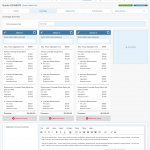NAS Online is the exclusive NAS Insurance portal for wholesale brokers to generate quotes and manage policies. For years the company had been struggling with an outdated interface and framework, and they engaged me to redesign the entire system from the ground-up as we launched the the final components of Snap, the internally-facing application for NAS underwriters (see Snap case study).
While it was critical that NAS Online v2.0 use the same back end as Snap, the front-end needed to function as a wholly different application with its own set of user requirements. With that, I engaged the company’s executives and underwriters in series of structured interviews and brainstorming exercises to determine the strategic and tactical goals, functional requirements, and brokers’ needs.
Not wanting to rely solely on the company’s perception of the required broker user experience, I also conducted a series of broker interviews to gauge their frustrations with the current NAS Online system, determine what brokers felt they needed from a redesigned system, and what aspects of the current system were working well. With that, I was able to define user personas for the brokers to help guide the design and implementation.
In conjunction with the stakeholder and user research, I analyzed a couple of similar systems for competing insurance carriers and did an extensive functionality and usability audit of the current NAS Online system. By overlaying this analysis with what we learned from stakeholders, underwriters, and the brokers themselves I was able to work with the NAS product team to create and prioritize a list of functional requirements. These requirements gave me the foundation for UI prototypes and would later evolve into functional stories for the development team.
Material Design
Notably, the brokers are NAS’ customers and they typically behave like consumer users. This is in contrast to the underwriters who use the Snap interface and have the benefit of proprietary knowledge and an in-house technical support team.
For brokers, we needed to present a much simpler, more intuitive user-interface that stripped away the more complex functionality with which NAS’ underwriters were more comfortable. What is more, the Snap system is used exclusively from desktop computers whereas NAS Online v2.0 needed to be usable from smartphones and tablets as well.
As a result, we decided to rely on Google’s Material Design system. While offering brokers UI patterns that they have likely encountered daily on multiple websites and applications, Material Design also offers NAS’ front-end engineers a ready-made framework to reduce production time.









